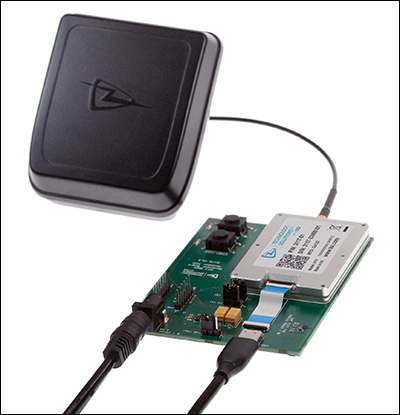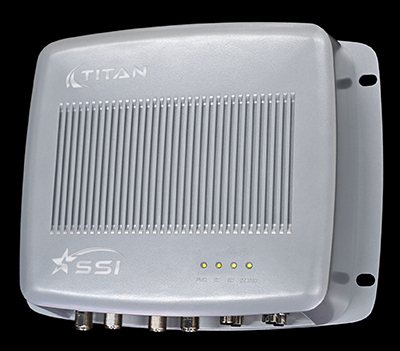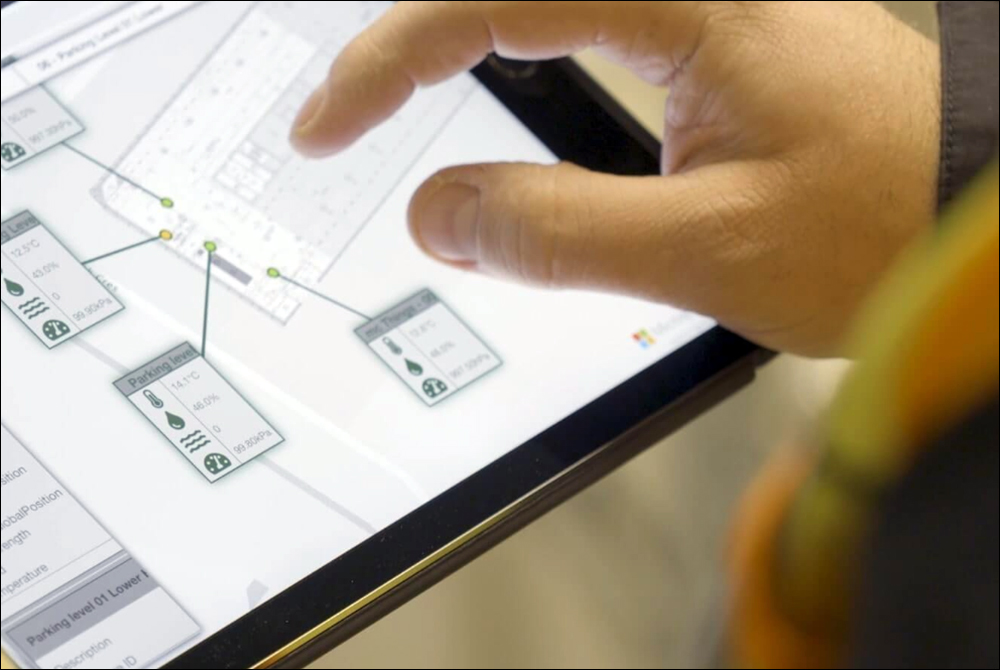- HID Adds Modules with Impinj Chips to Its RFID Reader Line
- Zebra Provides Channel Partners with RFID and RTLS Tools
- Mandalay Bay Adds RFID Locks to Remodeled Convention Center
- STAR Systems Receives E-ZPass Approval for Multi-Protocol Reader
- Kigen Manages SIM Ownership Transfer for AT&T IoT Customers
- Latium Technologies Updates PCL Construction IoT Platform
Presented here are recent news announcements in the radio frequency identification and Internet of Things industries.
HID Adds Modules with Impinj Chips to Its RFID Reader Line
HID Global has announced its first RFID reader modules featuring the company’s TSL technology and the STORM command protocol, intended to simplify embedded software integration. The modules, according to the company, enable developers to create customized reader hardware designs using Impinj‘s E710 and E910 reader chips.
 HID’s TSL RFID reader module family includes three options for designing compact fixed readers, as well as readers used in mobile and battery-operated handheld and wearable devices. Applications include asset tracking, inventory management, automation, safety and compliance, personnel tracking and authentication, in industries such as retail, healthcare, hospitality, transport, logistics, warehouse and distribution. The family includes the TSL 3117, with a single antenna port, based on the E710 reader chip; the TSL 3417, with four antenna ports, based on the E710 reader chip; and the TSL 3419, with four antenna ports, based on the E910 chip for enterprise-grade fixed readers.
HID’s TSL RFID reader module family includes three options for designing compact fixed readers, as well as readers used in mobile and battery-operated handheld and wearable devices. Applications include asset tracking, inventory management, automation, safety and compliance, personnel tracking and authentication, in industries such as retail, healthcare, hospitality, transport, logistics, warehouse and distribution. The family includes the TSL 3117, with a single antenna port, based on the E710 reader chip; the TSL 3417, with four antenna ports, based on the E710 reader chip; and the TSL 3419, with four antenna ports, based on the E910 chip for enterprise-grade fixed readers.
HID says the TSL reader modules offer a high read range, reader sensitivity and tag throughput, in a compact form factor designed for easy integration. Features include sensitivity greater than -90dbm, a tag-acquisition rate greater than 1,300 tags per second, and up to 50 percent lower power consumption than in previous-generation chipsets. The devices offer compatibility with latest-generation UHF sensor chips, which include the measurement of temperature, humidity, strain, acceleration and more.
These new reader modules are built to reduce reader design complexity, time-to-market and development costs through the STORM protocol, HID explains, enabling complex tag operations to be executed using preconfigured command sets. HID provides support for developers using a range of host devices and development environments, including a dedicated developer kit for the new modules.
Zebra Provides Channel Partners with RFID and RTLS Tools
Zebra Technologies has announced its new PartnerConnect Location and Tracking Specialization program for partners focused on selling RFID and real-time location system (RTLS) solutions. Developed as a component of Zebra’s PartnerConnect program, Location and Tracking Specialization provides resellers with tools to improve RFID and RTLS sales.
Zebra offers a portfolio of fixed and mobile RFID readers, as well as printer-encoders and tags. Its location and tracking solutions are intended to support the tracking of inventory, assets and individuals at retail stores, warehouses, distribution centers, manufacturing lines, hospitals and sports arenas, the company reports. The Location and Tracking Specialization program recognizes partner expertise and investment in passive and active RFID and RTLS technology solutions, Zebra explains.
Qualified program members will have exclusive access to business-building benefits, including prequalified leads, growth incentives, discounts on stock RFID label offerings, go-to-market support, marketing funding, channel account management and planning, and a customizable logo recognizing industry expertise. Those deemed “specialists” can sell and deploy location and tracking solutions, while “advanced specialists” can sell and deploy at an enterprise-wide scale and provide advanced integrations.
“With Zebra’s location and tracking solutions, partners can empower businesses to sense what’s happening, analyze or anticipate the implications, and decide their best next-action in real time,” said Bill Cate, Zebra’s VP of marketing and channels, in a prepared statement. “Zebra’s new Location and Tracking Specialization exemplifies how the PartnerConnect program helps our partners differentiate themselves with their customers, while making it easier to work with us to grow their business and get rewarded for their commitment, competency and performance.”
Mandalay Bay Adds RFID Locks to Remodeled Convention Center
Mandalay Bay Resort & Casino, located in Las Vegas, Nev., has unveiled details regarding the $100 million remodeling of its 2.1-million-square-foot convention center. This remodeling, according to the company, is intended to address the evolving needs and preferences of contemporary meetings, with technology upgrades, dynamic digital signage and a new design.
 Mandalay Bay has installed new Cat6A Ethernet cabling throughout its convention center. This, according to the company, provides planners with new methods to communicate with attendees via 11 dynamic digital walls measuring up to 24 feet by 13 feet each. The digital walls are designed for brand placements, sponsorship opportunities and targeted event messaging.
Mandalay Bay has installed new Cat6A Ethernet cabling throughout its convention center. This, according to the company, provides planners with new methods to communicate with attendees via 11 dynamic digital walls measuring up to 24 feet by 13 feet each. The digital walls are designed for brand placements, sponsorship opportunities and targeted event messaging.
The company has added 20 double-sided 55-inch mobile flexible display units, enabling attendees to find meeting rooms and events more easily. Additional technology enhancements include locks utilizing radio frequency identification (RFID) technology on all meeting room doors, as well as the installation of more than 200 new motion-detection cameras throughout all spaces.
The newly remodeled convention space was created by MGM Resorts International Design Group, in collaboration with Dezmotif Studios, and it is designed to combine contemporary design elements with practical enhancements, such as brighter lighting, streamlined signage and seating nooks. The center will feature artwork by Thandiwe Muriu and Sarah Anne Johnson, among others, and the project is expected to be completed by the end of 2024.
STAR Systems Receives E-ZPass Approval for Multi-Protocol Reader
STAR Systems International (SSI), a provider of smart-city products, has announced that its Titan Reader has been approved for revenue use on the E-ZPass system. With more than 50 million devices currently in circulation, E-ZPass is among the largest toll-collection programs in the world, comprising toll entities throughout 19 U.S. states. The multi-protocol Titan reader is now approved for use in this system.
 “E-ZPass is one of the most successful toll-collection programs in the world,” said Stephen Lockhart, the president of Star Systems America, in a prepared statement. “We are very happy to receive this approval for our Titan Reader and look forward to providing innovative, next-generation solutions that meet the growing needs of motorists served by E-ZPass.”
“E-ZPass is one of the most successful toll-collection programs in the world,” said Stephen Lockhart, the president of Star Systems America, in a prepared statement. “We are very happy to receive this approval for our Titan Reader and look forward to providing innovative, next-generation solutions that meet the growing needs of motorists served by E-ZPass.”
STAR Systems’ products are specifically designed for the high-speed environment of open road tolling. “E-ZPass is pleased to see STAR Systems has developed products that meet the standards of quality and performance that are required for use by our agencies,” added Jake Royer, E-ZPass Group’s technical manager, in the prepared statement. “We are looking forward to expanding approved products to our member toll agencies.”
Kigen Manages SIM Ownership Transfer for AT&T IoT Customers
Kigen has announced that it will manage and transfer subscriber identity modules (SIMs) across any form factor for device makers directly within AT&T Control Center, removing the burden of managing multiple SIM inventories. Original equipment manufacturers and device makers managing large volumes of customers can now receive SIMs to their required discrete, soldered or integrated form factor, as well as have ownership transferred to their customers’ Control Center accounts.
 With the process of taking SIM ownership made easier, Kigen explains, customers can gain native AT&T connectivity essential for accelerating their cellular IoT deployments. For all AT&T IoT customers, this ownership transfer can be managed within the AT&T Control Center. “Variations in sourcing the right form factor, profile and stock can be the cumbersome first step for businesses that are driving product innovation with new cellular technologies,” Kigen explained in a prepared statement. “Currently, the burden of working on multiple-party agreements can take weeks during the crucial stages of deployments for end-user enterprises.”
With the process of taking SIM ownership made easier, Kigen explains, customers can gain native AT&T connectivity essential for accelerating their cellular IoT deployments. For all AT&T IoT customers, this ownership transfer can be managed within the AT&T Control Center. “Variations in sourcing the right form factor, profile and stock can be the cumbersome first step for businesses that are driving product innovation with new cellular technologies,” Kigen explained in a prepared statement. “Currently, the burden of working on multiple-party agreements can take weeks during the crucial stages of deployments for end-user enterprises.”
A device manufacturer will typically manage at least one SIM inventory per customer, Kigen says, resulting in multiple stock-keeping units. Each inventory correlates to a unique combination of the SIM identifiers (ICC-ID, for example), with the required AT&T SIM profile and the end customer’s details. This, according to the company, can create complications for physical implementation on the manufacturing floor.
With this new process, end customers’ preferred module manufacturers can build a general inventory of AT&T-approved and -certified modules with SIMs in an integrated or other form factor, then bind them to the final AT&T Control Center account at the time of transfer, ready for activation. SIMs can be aggregated by device makers during the manufacturing and assembly processes, eliminating the need to keep a stock of AT&T SIMs per customer. This new process is already being adopted by module manufacturers, such as Murata.
Latium Technologies Updates PCL Construction IoT Platform
A year ago, Internet of Things (IoT) solutions provider Latium Technologies partnered with PCL Construction regarding the latter’s IoT-based Job Site Insights (JSI) application. Now, the companies have announced an upgrade to this platform. Throughout the past year, PCL has completed the integration of its JSI smart construction application with Latium’s Yonder operating system (yOS), with the intention of creating what the companies call “a more robust and powerful solution for both construction and industrial clients.” Among the businesses currently using the JSI platform are Trans Mountain, Enbridge, DPR, Webcor, Consigli and Davis Construction.
 Latium Technologies provides a suite of scalable IoT and industrial solutions for businesses in multiple industries, including construction, mining, oil and gas, and pipeline. Its solutions offer real-time telemetry, project management tools, job-site visualizations and resource scheduling. PCL Construction is a group of independent construction companies that carries out work in Canada, the United States, the Caribbean and Australia. It has operations in the civil infrastructure, heavy industrial and building markets, and these companies together report an annual construction volume of more than $8 billion.
Latium Technologies provides a suite of scalable IoT and industrial solutions for businesses in multiple industries, including construction, mining, oil and gas, and pipeline. Its solutions offer real-time telemetry, project management tools, job-site visualizations and resource scheduling. PCL Construction is a group of independent construction companies that carries out work in Canada, the United States, the Caribbean and Australia. It has operations in the civil infrastructure, heavy industrial and building markets, and these companies together report an annual construction volume of more than $8 billion.
The two companies began partnering in 2021, when Latium announced a merger with PCL’s Job Site Insights platform. That agreement combined PCL’s JSI with Latium’s yOS, allowing site supervisors, project managers and executives to enable critical business insights and predictions based on real-time data. The merger was intended to help companies improve worker safety, project quality and efficiency. According to the companies, Latium’s IoT and analytics platform has since enabled customers to adapt to changing conditions, as well as reduce costs and improve logistics and operational efficiencies.
Latium Technologies is now updating the platform. In the coming months, the companies report, the JSI product line will include an improved mobile app for both iOS and Android devices, featuring a simplified user interface, wizard-driven functions, voice recognition and visual media via the devices’ camera and video capabilities. In addition, the JSI Web portal will feature software-as-a-service (SaaS) updates that will incorporate feedback from the JSI user community, enabling the JSI software and hardware development team to design, build and provide solutions to meet the specific needs of the industries and clients Latium serves, particularly in oil and gas, construction and mining.
With the launch of the updated JSI product, Latium’s founder and president, Tony Pecorilli, will take over day-to-day operations from the company’s chief executive officer, Mark Bryant, as part of a planned transition. This change will allow Bryant to support PCL’s strategic initiatives as chief information officer, which includes Latium, a PCL operating entity. “Latium has delivered on its product enhancements and marketing launch goals, and the organization is well positioned to continue this strong momentum into 2023 under Tony’s leadership,” Bryant said in a prepared statement.


